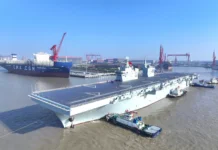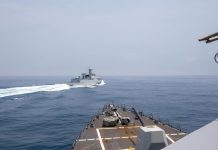
On Board the USS Boise in World War II. The battles and Secret Missions of Light Cruiser CL-47. By Ian S Bertram. McFarland and Company, Inc., Publishers, Jefferson, North Carolina (McFarlandBooks.com)
Reviewed by Tim Coyle
This book delivers exactly what it promises in the title. It is the wartime record of the USS Boise – a Brooklyn-class light cruiser (CL in the US Navy warship designation code) and number 47 in the CL listing. (‘light cruisers’ were internationally designated as such for their main armament comprising 6” guns. Their larger brethren – ‘heavy cruisers’ – sported 8” guns).
Boise’s wartime adventures are documented from extensive primary and secondary sources, but the focus is on the personal ‘log’ of Quartermaster Second Class Donald ‘DB’ (‘Duck Butt’) Fitch together with associated personal papers. DB was one of the 3.1 million personnel who served in 6768 ships of the US Navy in World War 2. His Quartermaster rating duty station – as part of the ship’s navigation team – was on the bridge; this allowed him the opportunity to be an eyewitness to all the ship’s life and actions from his first reporting on board Boise on 05 April 1941 to its decommissioning on 20 June 1946.
The author, Ian S Bertram, is a USAF pilot with MAs in History and International Relations. He was drawn to DB’s log through his wife – DB’s granddaughter – and his father-in-law’s recounting of DB’s adventures.
Bertram uses his history qualification to mine the enormous US military records including Boise’s War Diaries in the National Archives and various command and personnel records from all ranks. But through it all it is DB who is the primary storyteller and his lived wartime experience could be expanded into the millions of Allied service personnel who comprised what Americans call ‘the Greatest Generation’.
DB was perhaps typical of his generation emerging from the Great Depression and finding his world unsettled with the threat of war. Bertram summarises him as ‘a man born to hustle and make ends meet, traits he probably inherited from his father’. Rambunctious and a poor and disruptive student, he revelled in pranks and relished the outdoors through hunting and fishing.
Seeking an opportunity to leave his stultifying environment he joined the navy at 17 from Salt Lake City. After rudimentary naval recruit training, he joined Boise at Pearl Harbor on 06 April 1941. Shortly thereafter his new shipmates attached the imaginative sobriquet of ‘Duck Butt’ by adapting his middle name of ‘Bird’; ‘DB’ he would remain for the rest of his life.
For the next five years, he and Boise would be inseparable. He witnessed actions at Guadalcanal, Sicily, New Guinea and the Philippines. Relief from these intense experiences came through riotous booze- fuelled liberties (two in Sydney being particularly notable),
Boise was assigned to the America, British, Dutch, Australia (ABDA) scratch fleet in a desperate attempt to halt the Imperial Japanese Navy’s southern advance. However, on 20 January 1942, Boise struck an uncharted underwater object while part of an ABDA force tasked to intercept a Japanese force aiming to land troops at Balikpapan. This incident removed Boise from the ABDA order-of-battle and sent it on a frustrating sojourn to seek repairs, initially to Colombo, Ceylon and, where this failed, to Bombay, India.
As a result of Boise’s withdrawal, it missed the disastrous Battle of the Java Sea in which USS Houston, HMAS Perth and other allied warships were lost. Boise’s crew felt this personally as the ship received an unfair reputation as ‘The Reluctant Dragon’ in the fleet as it was believed Boise should have stayed and fought despite its hull damage (service personnel who believe – rightly or wrongly – that they have been ‘let down’ by other units can be particularly harsh critics).
Returned to service, Boise more than redeemed itself as a participant in the desperate naval battles around Guadalcanal. Many books and official histories have documented these battles, and Bertram admirably recounts Boise’s actions but with the added personal horrors experienced by DB and his shipmates when the ship suffered cataclysmic damage at the Battle of Cape Esperance. While claiming the partial destruction of six Japanese ships, Boise was hit on turret three which killed 107 men. DB’s personal trauma – shared with his shipmates – was the horrors experienced in collecting body parts. What we now call Post Traumatic Stress Syndrome was the inevitable result of such experiences.
Boise returned to the US for post action repairs and DB was able to take extended home leave which he spent largely isolated in the woods, accompanied by a stock of alcohol.
The ship was given a hero’s welcome in Philadelphia which, as time wore on and well intentioned, tended towards the extreme, so it was with a certain amount of relief that a repaired and worked up Boise, with replacement crew, was sent to join the invasion of Sicily and mainland Italy in 1943. By now Boise was a crack gunnery ship providing naval gunfire support to the amphibious forces. In November 1943 the ship a underwent stateside refit before heading back to the south-west Pacific to join General MacArthur’s New Guina campaign.
By this time Allied forces were well on the way of the ‘march north’ under MacArthur and the ‘island-hopping’ campaign under Nimitz. Boise was present at the Battle of Surigao Strait and the liberation of the Philippines – all culminating in intense levels of operations, exacerbated by the advent of the feared Japanese kamikazes.
One of the attributes of DB’s log is his keen observations of the vast numbers of ships he came across as a watch stander on Boise’s bridge. The Australian reader will note with satisfaction his mentioning of Australian ships, including the heavy cruisers Australia and Shropshire, with which Boise operated as part of TF-78 where, on 21 October 1944 at Leyte Gulf, he witnessed what is regarded as the first kamikaze attack when Australia was struck.
Ian S Bertram provides readers with an absorbing action narrative while featuring DB’s personal war as experienced in Boise. A such it is a fine achievement; however, a few minor critiques are noted in the text.
On page six, in describing the Brooklyn-class light cruisers, Bertram states: ‘Each turret was unique, custom-built for the Boise and slightly different from the turrets of its sister ships. The turrets were recorded as assembly numbers of 126-130 in the Bureau of Ordnance’s “Gun Mount and Turret Catalogue”. This meant that if any turrets were damaged, there were none available for speedy repair. Each was unique as the ship itself…’
Bertram’s reference (http://maritime.org/doc/guncat/cat-0478.php Gun Mount and Turret Catalog) shows that Boise’s 6-inch, 47 calibre Triple Gun Turrets were indeed listed as Assembly Numbers 126 through 130. His statement that ‘each turret was unique’ is quite wrong. The Brooklyn-class was the first to feature the 6-inch 47 calibre triple turret, but this installation became the standard main armament for subsequent CL classes (which included the most numerous 36-unit Cleveland-class). The notation on the data page: ‘Note: Assembly number of turret is required for precise information. Sketch numbers are subject to frequent changes’ appears to have been interpreted as giving some sort of exclusivity, but it is simply providing for modifications made to the mountings (‘uniqueness’ and ‘customisation’ are anathema to military forces).
Bertram returns to this theme on page 71. In narrating Boise’s return to the Philadelphia shipyard for repairs following the Battle of Cape Esperance, Bertram states: ‘Boise’s war was on hold. They needed extensive repairs, and the unique construction of the turrets alone meant replacement parts could not simply be rushed to the South Pacific’. This is only partly accurate. Boise had difficulties in accessing shipyards to rectify the damage sustained in the 1942 grounding which led it to seek repairs at Colombo and, when this was unsuccessful, at Bombay. At that early stage of the Pacific war the US Navy had a limited number of ARDs (floating docks) which could only lift ships up to destroyer size, so Boise could not have been accommodated for hull repairs in-theatre. For the major battle damage incurred at Cape Esperance which included a destroyed turret, a home base shipyard was the only option.
A parallel situation at this time was the repair to the heavy cruiser USS New Orleans, which had its bow blown off by a Japanese ‘Long Lance’ torpedo at the Battle of Tassaforonga on 30 November 1942. A heroic voyage to Sydney – 1200 miles away – saw New Orleans fitted with a ‘false bow’ at the Cockatoo Island dockyard which enabled it to return to the US for permanent rectification.
US Navy ship in-theatre repair facilities were transformed over the ensuing two years. This is illustrated in Bertram’s recounting Boise’s maintenance period following Leyte Gulf. In April 1945. Boise entered Advance Base Sectional Dock-4 on 12 April 1945. This enormous floating dock could lift 56 000 tons for hull repairs – a far cry from the dark days of 1942.
Two further minor comments:
- On page 25 a reference is made to the British submarine HMS Truant, which Bertram terms a ‘U-boat’. This term (Unterseeboot) was (and still is) exclusively applied to German submarines (Austro-Hungarian submarines of World War One were also so designated).
- On page 101 Bertram refers to HMS Abdiel as a ‘minesweeper’. Abdiel was a Fast Minelayer (3500 full-load displacement and capable of reaching 40 knots). The correct designation is on page 102 (in a quote from volume 9 of Samuel Eliot Morison’s official history).
The fortunes of war are starkly illustrated in relation to Abdiel: the British ship was in company with Boise in the Italian campaign with both ships entering Taranto harbour. The harbour pilot offered Boise a mooring, which the captain refused, and the cruiser secured alongside a commercial pier. Abdiel accepted the mooring Boise refused and apparently powered down its degaussing gear. While swinging at the mooring Abdiel activated a magnetic mine and sank with heavy loss of life.
The book’s Epilogue summarises DB’s postwar life. He continued his heavy drinking which affected family life, and he fathered four boys. He became successful in business, but his main dedication was to navy veteran organisations, particularly to his old Boise shipmates, a dedication he shared with millions of Allied service people.
DB stepped ashore on permanent liberty on 08 July 1998. To DB and all his Allied shipmates: ‘Fair Winds and following Seas’.



